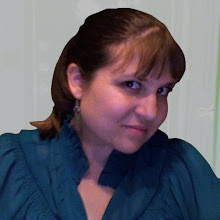A few weeks ago, as an exercise (given as a way to loosen us up, I believe) Denise took us through some free-word-association activities via iChat, which were great fun. We all sat at our computers in studio, all 12 of us crammed into one tiny chat room, all silently digitally hollering out answers at once. Paired with the real-time, real-life giggles and off-hand comments, it was a pretty surreal (but exciting) experience. The trigger questions to begin the word-association had to do with different genres of interface we had identified as a group at the beginning of class. For instance, "What if search tools....", and "What if video games.....?"After the word-association-mega-session was over, we each looked back over the iChat transcript and chose one of the responses to pair with our chosen genre.
I chose video games, and decided to focus on "What if video games held a grudge?"
Using this phrase as a prompt, we were asked to rapid prototype using several bags of junk we'd all brought in from home, which included: cardboard, paper scraps, glue sticks, 2 glue guns, dowel rods, pieces of wood, string, yarn, tape, bits and bobs, 2 bright pink NCSU mittens, a discarded calendar, broken toys and 3 tubes of glitter. We were given just 30 minutes to create something in response to our focus question. Here is my result:

We then took our prototypes into the auditorium next door, plopped them down on the first row of desks and held a critique. Denise pronounced us all "Designers" who were very much attempting to solve problems, and then asked us to repeat the exercise using the same prompt. However, this time, she wanted us to think about our response in a less literal way, and to really experiment with the materials at hand. My second attempt is far too sad and dismal to share even here, so I will spare you the visual. Suffice to say, I got caught up in playing with the paper hole punch and some cardboard, instead of pushing myself to do something interesting.
After a second critique, Denise asked us to go home and spend just an hour or so on a final response to our prompt, using any materials we liked. I created two versions:

This first attempt was created with a small box containing some plastic bits which I then wrapped with brightly colored ribbon, green yarn, and some brown cord. The yarn and cord were also knotted around the shape in some different patterns. My hope was to give the feeling of holding something or witholding something tightly. You could shake the shape, and tell that something was inside, but you just couldn't get to it.
The second object I made was certainly the most successful of the bunch:


In this final attempt, I used shrinkable plastic to create a more organic and alien feeling ball of witholding and holding back. I cut a small circle from the shrinkable plastic, and placed a bead on it and then melted/shrunk it in my toaster oven. I repeated that process several times with increasingly larger circles of plastic, always laying the plastic on the oven tray, and placing the previous ball on top of it. I was not able to fully control the process—the plastic flies up in this weird and alien way as it melts and shrinks, and it would grab hold of the ball atop it in different ways every time. Once the plastic had shrunk to a certain point, I would remove it, and press the edges around the ball until they cooled slightly, and repeat the process over again.
The result is this slick, bright white, shiny plastic ball that you want to just pull open, but you can't. Very odd and slightly disturbing even, which I think is an interesting response to the question "What if video games held a grudge?" No?















